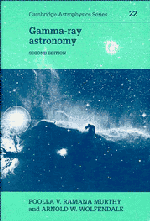3 - Gamma-ray bursts
Published online by Cambridge University Press: 06 July 2010
Summary
Introduction
The discovery of γ-ray bursts was serendipitous, as was that of pulsars, which were discovered at about the same time. Pulsars were first detected in 1967 in an experiment designed to study interplanetary scintillation of compact radio sources, and the discovery paper (Hewish et al. 1968) was subsequently published; the first γ-ray burst (GRB) was also seen in the year 1967 (although not reported until six years later; see Strong and Klebesadel 1976 for an account of the chronology) in a satellite-borne detector intended to monitor violations of the nuclear explosion test ban treaty. The publication of the discovery of GRBs was first made in 1973 by Klebesadel, Strong and Olson (1973). The detector comprised six caesium iodide scintillators, each of 10 cm3, mounted on each of the four Vela series of satellites (5A, 5B, 6A and 6B), these vehicles being arranged nearly equally spaced in a circular orbit with a geocentric radius of ∼ 1.2 × 105 km. The detectors were sensitive to individual γ-rays in the approximate energy range 0.2−1.5 MeV and the detector efficiency ranged from 17 to 50%. The scintillators had a passive shield around them; background γ-ray counting rates were routinely monitored. A statistically significant increase in the counting rates initiated the recording of discrete counts in a series of quasi-logarithmically increasing time intervals. The event time was also recorded. Data were telemetered down to the ground-based receiving stations.
- Type
- Chapter
- Information
- Gamma-ray Astronomy , pp. 43 - 110Publisher: Cambridge University PressPrint publication year: 1993



